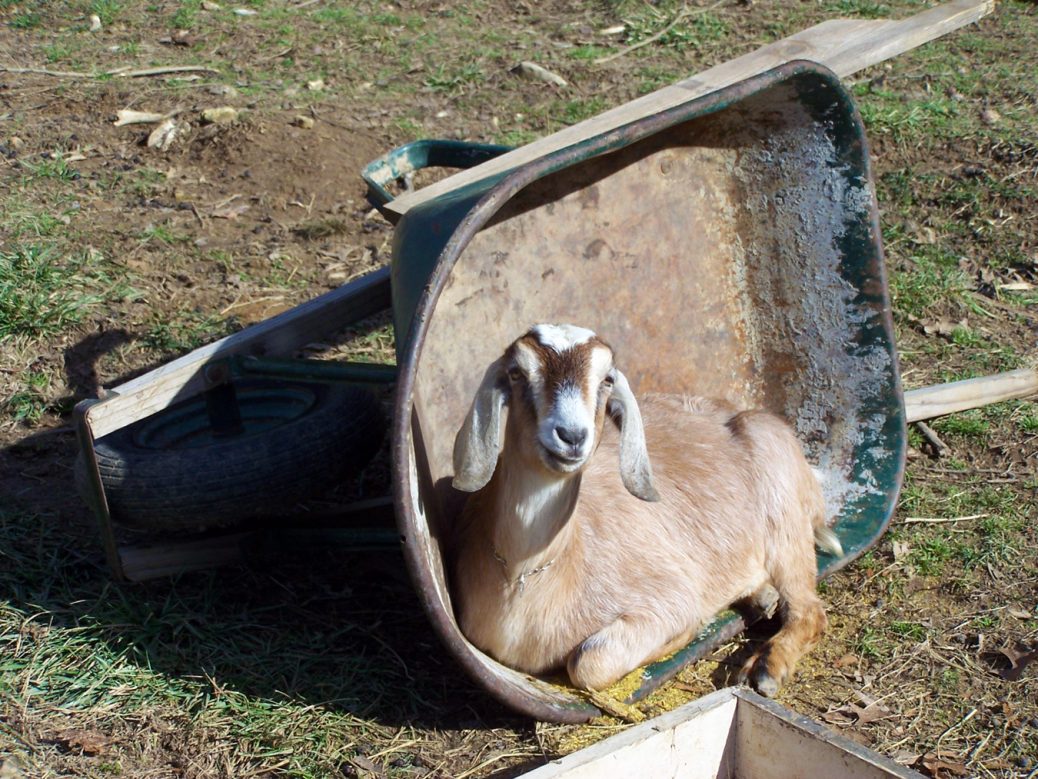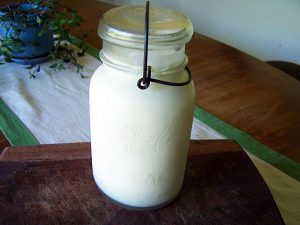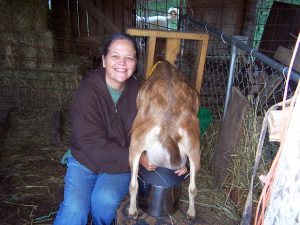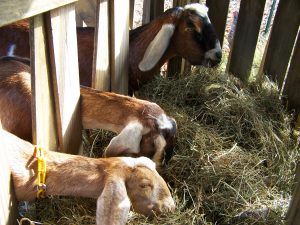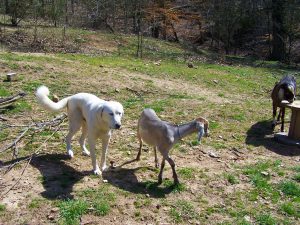By Karen M. House
Back in the early nineties, my husband and I started thinking about getting dairy goats. We were looking at the likelihood that things in the United States would soon go south, and at the time we had three children. We thought having a source of dairy products would be a good idea on our little homestead. That way, we would have milk and cheese for calcium and protein, to supplement the vegetables we could grow in a garden.
Goats are known as “the poor man’s cow.” A goat produces about a fifth of the milk a cow does each day, but they eat a lot less, too. Goats have “litters,” too, of one to five kids, while a cow usually has just one calf each year, so while the death of a cow might mean the complete loss of dairy products, a goat is not nearly as hard to replace.
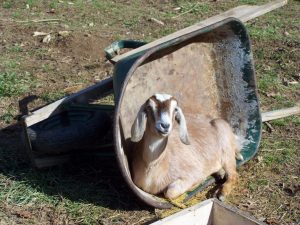
In those days before the Internet, we were not quite sure where to start in our search for a goat. We didn’t know anyone who raised them. One day, we lucked out; we spotted an ad in the local paper offering free composted goat manure. Where there was manure, there had to be a lot of goats!
We called, explaining that we were interested in getting some goats, and went over to see their herd. The Moores had a group of registered Alpines and LaManchas that they had been taking to goat shows, but since their children were growing up — and into other areas of interest — they were thinning their herd. I asked them if they drank the milk, and much to my surprise, they didn’t! Later, I found out that a lot of show people raise their goats just for competition, and don’t ever drink the milk.
To me, this is as sad as a toy collector keeping toys sealed up never to be played with by a child, or a herding dog that never gets the chance to chase a sheep or cow and spends its days chasing cars instead. Something that came into the world designed to accomplish a certain task will never fulfill its purpose apart from that task.
Besides, I thought, if you never taste the milk, how do you know if your goat is a good dairy animal or not? I would rather have a goat with great-tasting milk than one that looks perfect but produces bad milk.
Well, a deal was made. Terry swapped a .22 rifle to the Moores for five goats they wanted to cull from their herd. I found out many years later that it is not a good idea to buy someone else’s rejects, but we were novices then, and just happy to have found some dairy goats.
We drove the 30 miles home that day in our Dodge Omni… my husband, me, three children, and five goats. I can still hear the screams.
“Ma-MA-A-A-A,” my baby wailed, as a goat leaned over from the hatch area and nibbled her hair where she sat in her car seat.
I held the little buckling in my lap. The other four goats were crammed in the hatch. The three human kids were strapped into the back seat. Oh, the looks we got from fellow motorists on the highway that day!
My little girl was not the only one in mental anguish on the way home. I suffered my own trauma, because the buck kid kept urinating on me. I remember when we stopped at the store on the way. My husband ran in to get something and when he got back, I was weeping, clutching that goat kid on my knees.
“He p-p-peed on me again,” I whimpered. That made three times so far, and there wasn’t a thing in the world I could do about it. We had to get home.
That was our first herd of goats. Included among them was a doe with an immaculate pedigree that could not seem to get pregnant and a LaMancha buckling whose ears were too long, so he could not be registered with the American Dairy Goat Association (ADGA). When we took him, we were told that he was only good for hamburger, so that’s what we named him: Hamburger.
Dairy goat breeds
The ADGA recognizes eight breeds of dairy goat: Alpine, LaMancha, Nubian, Oberhasli, Saanen, Sable, Toggenburg, and Nigerian Dwarf. As we became familiar with the animals and the registry organization, we found out more about what distinguishes the various breeds:
Alpines are medium-sized goats of various colors and color combinations. They have erect ears and (in my opinion) a slightly aloof personality.
LaManchas were developed in America from a combination of already existing breeds of dairy goats mixed with a native earless goat on the West Coast. Bucks are not eligible for registration unless they have a “gopher” ear (less than one inch). Does may have gopher ears or “elf” ears (up to 2 inches long). LaManchas have an easygoing personality, although it is my experience that they are more vocal. They are less affected by harsh conditions and produce high-butterfat milk.
Nubians are an ancient breed that originated in Africa and were interbred with British goats to make “Anglo-Nubians”. They are large goats with long, floppy ears and a distinctive Roman nose. It is my experience that Nubians show more interest in their humans than other goats do. They produce smaller quantities of richer milk than other breeds — usually a gallon or less a day.
Oberhasli were developed in the Swiss Alps. They are medium-sized goats with erect ears that are chamoisee (bay ranging from light to a deep red bay) or black.
Saanens are big, white goats with erect ears. They produce the most milk of all the breeds.
Sable is a relatively new breed that splintered off from the Saanens. Occasionally, a dark-colored Saanen would be born — a good dairy animal, but unregisterable as a Saanen because it was not white. So, the ADGA formed a separate category. Sables may be any color or color combination except white or cream.
Toggenburgs were the first animals of any kind registered in the United States. They are medium-sized, in varying shades of brown with light-colored facial stripes.
Nigerian Dwarf is the most recent breed accepted to the ADGA registry, and as the name implies, it is a miniature dairy goat. It originated in West Africa and was developed in the United States. Dwarfs may be any color or combination of colors, and some even have blue eyes. They have erect ears and are less than two feet at the shoulder. They give the highest butterfat, on average, of any of the dairy breeds.
Learning to love milk
Over the next few months, we began to learn how to keep and milk dairy goats. It wasn’t long before our first kidding. We came home from town one rainy day, and as we pulled up the driveway, I saw the yearling LaMancha doe, “Chevy,” standing there in the pouring rain, looking at a soggy bundle at her feet. She had given birth to a little doe kid, but as a first freshener she hadn’t a clue what it was or what to do with it.
I bundled the shivering little thing up in a thick towel and took it in the house. “Casey” was our first kid, and growing up in my living room, she thought she was human. I still remember how she would tap dance on the hood of the car when I let her out in the yard to enjoy the sunshine. We joked about how some people in the Walmart parking lot had cat prints on the hood of their car, but we were the only ones with tiny goat prints!
That first small herd of dairy goats also introduced us to the taste of goat milk. My daughter, who was a toddler at the time, would follow me out to the milking shed with her bottle in her hand, waiting for her milk. If I ever tried to slip a little cow’s milk in her bottle, she knew the difference right away, and would make a face.
We sold Hamburger to some Mennonites who had a milk cow and a few milk goats. The father was lactose-intolerant and had heard that goat’s milk was something his stomach could handle, so they had bought a couple of dairy goats. They just needed a buck to breed with them. Since they had no interest in showing goats or registering them, the length of Hamburger’s ears didn’t matter in the least.
Goat milk is closer in composition to human milk than cow milk is, therefore people who are lactose-intolerant usually have no problem with goat milk. A lot of hospitals used to buy goat milk to use in their nursery to feed the babies.
Goat milk that is handled correctly tastes just like cow milk. Some breeds — notably, the Nubians, LaManchas, and Nigerian Dwarfs — produce higher levels of butterfat, which makes their milk sweeter and more delicious than anything found in the grocery store.
Some people don’t believe goat milk tastes good, but that’s usually because the only milk they’ve tasted came from dirty conditions or from does that were kept in with the bucks. Goat milk is delicate, and easily influenced by the conditions in which it is produced and processed. If the goats have been feeding on wild onions, the milk will have a faint onion taste. If your utensils are not sanitary, the milk will have an off-flavor.
Over the years, we have frequently kept the buck in with the does without a problem, but a lot of goatherds don’t do that because the scent of the buck can influence the milk, especially during breeding season — called “the rut.”
If you or someone you know is an avid deer-hunter, you probably know that breeding season for deer also is called the rut. That should clue you in to the fact that goats are very similar to deer. They eat like deer, browsing on tender leaves and twigs and not eating grass unless there is nothing else to eat. Their rut, likewise, is in the fall, just like the deer rut.
Although a few types of goat can breed year-round, most goats breed from about September to December. Their gestation period is 5 months, which means the kids hit the ground starting in about February — God’s way of providing plenty of good browsing for the growing kids through the spring and summer.
Our second herd of goats also was a package deal. A young college student had been raising show goats all through high school, and when he got in college and quit spending time with the goats, the herd kind of got out of hand. When we met John, he had an old buck named Scorpion and several dozen does — some of which were wild as deer.
We bought about half-a-dozen Alpine does from John, including Bon-Bon (a heavy milker with an overbite that disqualified her for show), Mist (one of the wild-as-deer girls), Blackberry (also very wild), and a couple of others.
I remember Blackberry could leap straight up in the air in an arabesque, and me with a death-grip on her collar! Mist was memorable for two things: Her ability to fly over a five-foot-tall fence and her first encounter with the milking stand, which she busted to pieces.
As I got to know these two girls, I realized Mist was shy and would never go far from the other goats. If she jumped the fence, she would browse a while in the yard and then jump back in. Blackberry gentled down and became such a good and dependable milker that when she left the farm, she was sold to a man starting up a commercial goat dairy.
The friend who had adopted Odie, the registered doe who couldn’t get pregnant, informed us that she’d had twins by a neighbor’s bush goat, who’d got in with her by accident. When we questioned what he’d been feeding her, he told us he gave her the same Red Cell vitamin supplement he gave his horses. It turned out that our area was low in naturally occurring selenium, and that can cause a goat to be infertile. He returned Odie to us and kept the twin kids, and we got some vitamin supplements with selenium to feed our herd.
Three other goats completed our new herd: a Nubian doe kid from a neighbor of John’s and a buckling and doeling from a breeder of purebred Alpine dairy goats.
We named the little Nubian doeling Brown Sugar, and we picked her up when she was just a few hours old. We purchased some Colostrix from the farmers’ co-op, because it is essential that a newborn animal of any kind get that first “milk” from their mother — really not milk at all, but a watery liquid packed full of vitamins, minerals, and antibodies to help the little one face the challenges of their new germ-infested environment. If the animal does not get it from their mother, they have little chance of survival. Colostrix is a manufactured substitute for the natural colostrum a mother provides through her mammary system in the first hours after giving birth. Raised on a bottle, Sugar thrived and grew, and won our hearts with her easygoing personality.
The registered Alpines we got from the goat breeder were a lovely doeling named Secret and a buckling with a mop-top of curls on the top of his head. We called him Topper.
All in all, we ended up with about a dozen goats — mostly Alpines, with the one little Nubian thrown in.
Our first kidding season was spectacular. Topper threw a whole slew of white kids. Technically, they were what the ADGA calls “chamoisee” — a light color with a black streak down the back and up the belly. Half of Topper’s get that first year were the color of milk with black trim, and they were beautiful! Out of that kid crop, we got our new herd sire, as Odie had a buck kid that was white as milk with beautiful black points. We named him King David.
As herd animals, goats are creatures of habit. Raising kids on bottles, I found them to be friendly and totally trusting of humans. Feeding the wild does grain in the milking stand quickly got them used to the routine of jumping up on the stand every morning and evening.
A milking stand makes milking easier by restraining the milk goat. A little feed in the pan keeps her occupied while she’s being milked. (This is the author milking a LaMancha dairy goat.)
Practical tips for the novice goatherd
People who complain that their goats get into mischief or won’t stay in the pasture shouldn’t blame the goats. If a goat has a sturdy fence, plenty to eat, and a companion to hang out with, she won’t get into trouble.
We found the best fencing to be a hogwire or stock panel fence, with a strand of barbed wire or electric fence along the top. The best mix would be hogwire for the pasture fence, and stock panels along the side near the house and barn, where the goats are most likely to put their feet up on the fence. Make sure the gate is taller and sturdier than the fence itself, because goats are smart, and if they see their humans continually going in and out at the gate, that is the first place they will try to break out.
Goats can thrive on browse alone if you pasture them at a rate of no more than two goats for every acre of good brushy pasture. The best browse for goats is a mix of leafy plants and legumes: blackberry briars, lamb’s quarters, poison ivy, clover, chicory, orchard grass, lespedeza, and alfalfa. Try to avoid fescue, which can cause problems during pregnancy, and mountain laurel, which is poisonous.
A salt block or mineral block and fresh water should always be available.
When milking, lactating goats will need a little additional feed, and this is easily supplemented in the milking stand by putting a cup or two of commercial dairy goat ration in the bowl. It has a side-benefit of giving the doe something to do while you’re milking. Be sure to lock the goat’s head in the stanchion, so she can’t get down if she finishes before you do.
Stock panels are good fencing choices around the barn, where the curious occupants like to put their hooves up on the fence to get a better look at what’s on the other side!
We always put up some hay for the winter. Lespedeza or orchard grass is best. We have fed alfalfa hay, which has high levels of calcium and protein and thereby increases production. But I have two caveats about feeding alfalfa: Bucks can develop urinary calculi (kidney stones) from the high calcium levels of alfalfa, and some varieties of alfalfa are genetically modified (GM), which can cause infertility and cancer. Usually alfalfa is very expensive, too.
Remember that goats are herd animals. Never buy just one goat; those are the ones that will get into trouble! Two goats (or more) will develop their own pecking order and will keep each other company. Plus, if you have a goat that likes to break out — like our Mist — she won’t go far from the herd.
Other items you need if you decide to keep a dairy goat herd is a simple shelter for your herd to get out of the weather, and a livestock guardian dog (LGD) to protect them from predators.
A livestock guardian dog, like this Akbash, is essential to keep a dairy herd safe from predators.
That first kidding season with our second herd we had a Great Pyrenees named William Wallace. Even though he was just a year old, he knew what his job was. He barked when the coyotes went through the valley (we never lost a goat to coyotes), and he stood over our does when they kidded.
One of the first kids to hit the ground that spring came right at dusk. I was fixing supper and I heard William Wallace barking. It sounded like an urgent bark, but not like he was after a predator. I went to see what was wrong, and there he stood, between the new mama and the shed, where all the other goats were watching wide-eyed. The doe had produced a kid, and was licking it off, and dear William was making sure the other goats kept their distance! I would not attempt to have a herd of goats without a good dog to protect them.
Should you decide to get dairy goats, I recommend contacting the ADGA. They will mail out a packet of information on dairy goats at no cost. And it’s not a bad idea to become a member. In 2014, the membership fee is $35, which gives you access to a wealth of information through the club and a member directory, which can put you in touch with goat owners and breeders throughout the country.

